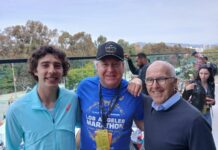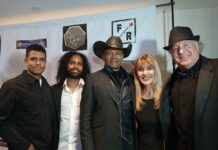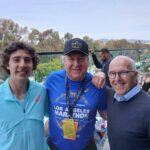It’s time for Summer at The Flamingo Las Vegas Pool , with the wildest and hottest pool parties in town , with live entertainment , music, Djs, food and drinks, water slide , and a beautiful tropical paradise. There is big name entertainment and concerts on a stage built right by the edge of the pool. & Coming up May 6th is Taboo from The Black Eyed Peas !

The Black Eyed Peas (originally simply Black Eyed Peas) is an American group, consisting of rappers will.i.am, apl.de.ap, Taboo, and singer Fergie. Originally an alternative hip hop group, they subsequently changed their musical sound to pop and dance-pop music. Although the group was founded in Los Angeles in 1995, it was not until the release of their third album Elephunk in 2003 that they achieved high record sales. Since that time, the group has sold an estimated 76 million records (35 million albums and 41 million singles), making them one of the world’s best-selling groups of all time. In 2009 The Black Eyed Peas released “I Gotta Feeling“ (produced by David Guetta). The single charted at number three and then went to number one on the UK Singles Chart. It debuted at number 2 on the Billboard Hot 100 behind “Boom Boom Pow” and later surpassed it, taking the number 1 spot. The Black Eyed Peas joined a group of artists who have held the No.1 and 2 Spot on the Billboard Hot 100 simultaneously. From April 18, 2009, when “Boom Boom Pow” reached No. 1, through October 10, 2009, the last week “I Gotta Feeling” was at No. 1, the group was on top of the chart for 26 weeks, more consecutive weeks than any other artist ! According to Nielsen SoundScan, the Black Eyed Peas were the second-best-selling artist/group of all time for downloaded tracks, with over 42 million sales as of the end of 2011.

The Black Eyed Peas on the red carpet at The Grammy Awards at Staples Center
So make sure you see Taboo of the The Black Eyed Peas when he performs 5-6-17 @ The Flamingo Las Vegas Pool ! & Just a hop, skip, and a jump from The Flamingo Pool on The Las Vegas Strip is Bally’s Las Vegas Hotel and Casino – Indigo Lounge , which is designed by nightlife impresario Victor Drai , who made the lounge a hot nightlife and entertainment destination set at the center of the Strip. The Indigo Lounge recaptures the splendors of a refined Las Vegas nightlife experience. Expect impeccable service, hand-crafted cocktails and sublime live entertainment. 
While you are at The Flamingo Pool -make sure that you check out the rest of the property, that includes a 77,000-square-foot (7,200 m2) casino along with 3,626 hotel rooms. The 15-acre (6.1 ha) site’s architectural theme is reminiscent of the Art Deco and Streamline Moderne style of Miami and South Beach, with a garden courtyard housing a wildlife habitat featuring flamingos. It was the third resort to open on the Strip, and it is the oldest resort on the Strip still in operation today. The Flamingo has a Las Vegas Monorail station, the Flamingo/Caesars Palace station, at the rear of the property. After opening in 1946, it has undergone a number of ownership changes.
The Flamingo site occupies 40 acres originally owned by one of Las Vegas’ first settlers, Charles “Pops” Squires. Squires paid $8.75 an acre for the land. In 1944, Margaret Folsom bought the tract for $7,500 from Squires, and she then later sold it to Billy Wilkerson. Wilkerson was the owner of The Hollywood Reporter as well as some very popular nightclubs in the Sunset Strip: Cafe Trocadero, Ciro’s and La Rue’s.{Los Angeles}La Rue Restaurant’s Sunset Blvd.
In 1945, Wilkerson purchased 33 acres (13 ha) on the east side of U.S. Route 91, about 1-mile (1.6 km) south of the Hotel Last Frontier in preparation for his vision. Wilkerson then hired George Vernon Russell to design a hotel that was more in the European style and something other than the “sawdust joints” on Fremont Street. He planned a hotel with luxurious rooms, a spa, health club, showroom, golf course, nightclub, an upscale restaurant and a French style casino. Due to high wartime materials costs, Wilkerson ran into financial problems almost at once, finding himself $400,000 short and hunting for new financing.
Development under Bugsy Siegel (1945) :
In late 1945, mobster Bugsy Siegel and his “partners” came to Las Vegas, after the fledgling resort city piqued Siegel’s interest due to its legalized gambling and its off-track betting. Siegel at the time held a large interest in Trans America Wire, a racing publication.
Siegel began by purchasing the El Cortez on Fremont Street for $600,000. His expansion plans were hampered by unfriendly city officials aware of his criminal background, so Siegel began looking for a site outside the city limits. Hearing that Wilkerson was seeking extra funding, Siegel and his partners, posing as businessmen, approached him and bought a two-thirds stake in the project.
Siegel took over the final phases of construction and convinced more of his underworld associates to invest in the project. Siegel lost patience with the rising costs, and his notorious outbursts unnerved his construction foreman, Del Webb. Reportedly, Siegel told him, “Don’t worry — we only kill each other.”
Siegel had also built a secret ladder in the “Presidential Suite” to escape if necessary. The ladder led down to an underground garage where a chauffeured limo was also waiting.
The Flamingo Hotel & Casino opens (1946) :
Siegel finally opened The Flamingo Hotel & Casino at a total cost of $6 million on December 26, 1946. Billed as “The West’s Greatest Resort Hotel,” the 105-room property and first luxury hotel on the Strip, was built 4 miles (6.4 km) from Downtown Las Vegas, with a large sign built in front of the construction site announcing it was a William R. Wilkerson project, with Del Webb Construction as the prime contractor and Richard R. Stadelman (who later made renovations to the El Rancho Vegas) the architect.
Lore has it that Siegel named the resort after his girlfriend Virginia Hill, who loved to gamble and whose nickname was “Flamingo,” a nickname Siegel gave her due to her long, skinny legs. Organized crime king Lucky Luciano wrote in his memoir that Siegel once owned an interest in the Hialeah Park Race Track and viewed the flamingos who populated nearby as a good omen. In fact, the “Flamingo” name was given to the project at its inception by Wilkerson.
Siegel’s murder over profits (1947) :
Siegel’s trouble with the Flamingo began when, a year after the official groundbreaking, the resort had produced no revenue and drained the resources of his mob investors. Then Meyer Lansky charged — at a major mob conference in Cuba — that either Siegel or Hill was skimming from the resort’s building budget, a charge amplified when Hill was revealed to have taken $2.5 million and gone to Switzerland, where the skimmed money was believed to be going.
“There was no doubt in Meyer’s mind,” Luciano recalled in his memoir, “that Bugsy had skimmed this dough from his building budget, and he was sure that Siegel was preparing to skip as well as skim, in case the roof was gonna fall in on him.” Luciano and the other mob leaders in Cuba asked Lansky what to do. Torn because of long ties to Siegel, whom he considered like a brother, Lansky nevertheless agreed that someone stealing from his friends had to go. At first, Lansky persuaded the others to wait for the Flamingo’s casino opening: if it was a success, Siegel could be persuaded in other ways to repay. Luciano concurred and persuaded the others to agree.
The splashy opening — stars present included Spanish band leader Xavier Cugat (whose band provided the music), George Jessel, George Raft, Rose Marie, and Jimmy Durante as entertainment, with guests including Clark Gable, Lana Turner, Cesar Romero, Judy Garland, Joan Crawford, and others — was a flop. Lansky managed to persuade the mob chiefs to reprieve Siegel once more and allow the Flamingo more time. But by January 1947 Siegel had to order the resort closed until the hotel could be finished.
The Flamingo re-opened in March despite the hotel not being complete, and this time, the results proved different. By May, the resort reported a $250,000 profit, allowing Lansky to point out that Siegel was right about Las Vegas after all. But it wasn’t quite enough to save Siegel. On June 20, 1947, relaxing in the Beverly Hills house he shared with Hill, who was away at the time, Siegel was shot to death. A memorial plaque exists on the Flamingo site near the outdoor wedding chapel.
Post-Siegel ownerships (1947–1960) :
Casino management changed the hotel name to The Fabulous Flamingo on March 1, 1947, and in time the Flamingo presented lavish shows and accommodations for its time, becoming well known for comfortable, air conditioned rooms, gardens, and swimming pools. Often credited for popularizing the “complete experience” as opposed to merely gambling, the Flamingo staff became known for wearing tuxedos on the job. Among the many entertainers who performed at the Flamingo between 1947 and 1953 were Martin and Lewis, Sammy Davis Jr., Danny Thomas, Tony Martin, Marge and Gower Champion, Polly Bergen, Lena Horne, The Mills Brothers, Alan King, Betty Hutton, Billy Eckstine, Sophie Tucker, Pearl Bailey and Spike Jones.
In 1953, the Flamingo spent $1 million in renovations and remodeling. The original entrance and signage was destroyed. A new entrance with an up swept roof was built and a pink, neon sign was designed by Bill Clark of Ad-Art, and a neon-bubbled “Champagne Tower” with pink flamingos rimming the top was installed in front of the hotel. From 1955 to 1960, the Flamingo was operated by Albert Parvin of the Parvin-Dohrmann Corporation. Parvin owned 30% of the stock, while businessman Harry Goldman owned 7.5%; other investors included singer Tony Martin and actor George Raft.
Recent years (1960–present)
In 1960, it was sold for $10.5 million to a group including Samuel Cohen, Morris Lansburgh, and Daniel Lifter, Miami residents with reputed ties to organized crime. Lansky served as middleman for the deal, receiving $200,000.
Kirk Kerkorian acquired the property in 1967, making it part of Kerkorian’s International Leisure Company, but the Hilton Corporation bought the resort in 1972, renaming it the Flamingo Hilton in 1974. The last of the original Flamingo Hotel structure was torn down on December 14, 1993 and the hotel’s garden was built on the site. The Flamingo’s four hotel towers were built (or expanded) in 1977, 1980, 1983, 1986, 1990, and 1993. A 200-unit Hilton Grand Vacations timeshare tower was opened in 1993.
In 1998, Hilton’s gaming properties, including the Flamingo, were spun off as Park Place Entertainment (later renamed to Caesars Entertainment). The deal included a two-year license to use the Hilton name. Park Place opted not to renew that agreement when it expired in late 2000, and the property was renamed Flamingo Las Vegas.
In 2005 Harrah’s Entertainment purchased Caesars Entertainment Inc and the property became part of Harrah’s Entertainment company, which changed its name to Caesars Entertainment Corporation in 2010.
On September 9, 2012, Port Adelaide Football Club AFL footballer John McCarthy died after falling 30 feet (9 m) from a rooftop of the hotel. The incident occurred at the start of a post-season holiday for McCarthy and other Port Adelaide players. They had arrived in Las Vegas only a few hours before the incident. After reviewing evidence, police said that McCarthy had attempted to jump off the roof onto a palm tree, but fell to the ground.
Facilities and attractions :
The 15-acre site’s architectural theme is reminiscent of the Art Deco and Streamline Moderne style of Miami and South Beach, with a garden courtyard housing a wildlife habitat featuring flamingos. It was the third resort to open on the Strip, and it is the oldest resort on the Strip still in operation today. The Flamingo has a Las Vegas Monorail station, the Flamingo/Caesars Palace station, at the rear of the property.
The garden courtyard houses a wildlife habitat featuring Chilean flamingos, Ringed Teal ducks, and other birds. There are also koi fish and turtles. It was the home of penguins, but they have since been moved to the Dallas Zoo. Extending the hotel’s tropical theme, a Jimmy Buffett’s Margaritaville restaurant and gift shop was opened in December 2003. An adjacent Margaritaville “minicasino” opened in October 2011.
Previous headliners include Gladys Knight, Toni Braxton, and comedian Vinnie Favorito. Braxton’s show ran from August 2006 to April 2008, when it closed due to Braxton’s health problems. X Burlesque also resides at the hotel.
Current headliners :
As of 2016 the headline show at the Flamingo features brother-sister musical duo Donny and Marie Osmond. Their show premiered in September 2008, and was extended through November 2016 , and is still going now ! The Donny & Marie show uses the “Old Showroom” format from the early days of Vegas featuring a 750-seat theater with tables and booths. The old style showroom was remodeled in 2014 and renamed the Donny and Marie Theater. The show was rated The Best of Las Vegas and voted Best Performers of Las Vegas in 2012, 2013 and 2014. Singer Olivia Newton-John started a residency at the Flamingo in April 2014, which was extended through 2016, and is also still going now. She alternates showroom dates with Donny and Marie.
Film :
The 1964 film Viva Las Vegas and the 1960 version of Ocean’s 11 were filmed at the hotel, as was a flashback sequence from the 2001 version of the latter film. In the original one’s story, the Flamingo was one of the five Las Vegas casinos robbed by the characters played by Dean Martin, Frank Sinatra, Peter Lawford, Sammy Davis Jr. and others.
The 1991 film Bugsy starring Warren Beatty depicted Bugsy Siegel‘s involvement in the construction of the Flamingo, though many of the details were altered for dramatic effect. For instance, in the film, Siegel originates the idea of the Flamingo, instead of buying ownership from Billy Wilkerson, and is killed after the first opening on December 26, 1946, rather than the second opening of the Flamingo in 1947.
Television :
The Netflix original series Lilyhammer featuring E-Street Band guitarist and singer Steven Van Zandt features a nightclub in Lillehammer, Norway, named the Flamingo. During its construction, Van Zandt’s character, Giovanni Henriksen (aka Frank “The Fixer” Tagliano), referenced the hotel and casino, as well as Benjamin Siegel, as his inspiration for the nightclub.
Music :
The début solo album from The Killers‘ lead singer Brandon Flowers, Flamingo, is named after the casino.
Literature :
Hunter S. Thompson and Oscar Zeta Acosta stayed at the Flamingo while attending a seminar by the National Conference of District Attorneys on Narcotics and Dangerous Drugs held at the Dunes Hotel across the street. Several of their experiences in their room are depicted in Thompson’s Fear and Loathing in Las Vegas: A Savage Journey to the Heart of the American Dream.
The original Flamingo hotel and casino figures prominently in the Tim Powers novel Last Call. In the novel, the famed myth of Siegel’s creation of the Flamingo was utilized as a basis for the overall supernatural plot of the novel (rather than the true historic account of his acquiring it from the original founder). The Flamingo is supposedly founded on Siegel’s mythical/mystical paranoia of being pursued and killed for his Archetypal position as the “King of the West,” known mythologically as “Fisher King.” Supposedly the Flamingo itself was meant to be a real-life personification of “The Tower” card amongst the Major Arcana of the Tarot deck, literally “the King’s Castle in the Wasteland.” In the book, it is believed Siegel kept in the Flamingo hotel’s penthouse a deck of the fictional Lombardy Zeroth Tarot deck. Siegel’s penthouse and office floor did, as referenced in the novel, in fact have a secret escape-hatch complete with ladder down to a service floor where supposedly a car was always in ready to effect his getaway in the event of his being attacked in his chambers. All other references to the Flamingo in any supernatural context in the novel are not based on any known or recorded facts/events.
Games :
On February 17, 2012, a slot machine game named Flamingo was added to the Slotomania game on Facebook. This game is themed after the casino and mentions at the log-in screen that the Flamingo was the first casino “on the strip” (their capitalization). According to a post on the Flamingo’s Facebook page, Slotomania is their own application.
Stay tuned for many more stories from Las Vegas !






















